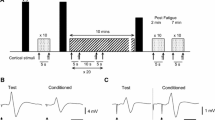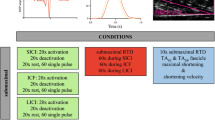Abstract
Terminating a voluntary muscle contraction is an important aspect of motor control, and yet, its neurophysiology is unclear. The objective of this study was to determine the role of short-interval intracortical inhibition (SICI) by comparing SICIs during relaxation from a power grip versus during a sustained power grip at the matching muscle activity level. Right-handed healthy young adults gripped and relaxed from power grip following auditory cues. The relaxation period was determined as the time for the flexor digitorum superficialis (FDS) muscle to reach its pre-contraction baseline level after the cue to relax. SICI during relaxation was obtained at different times into the relaxation period in two separate studies (70, 80, 90 % into relaxation in Study 1; 25, 50, 75 % into relaxation in Study 2). In addition, SICI during sustained contraction was assessed while subjects maintained a power grip at the matching FDS EMG levels (obtained during relaxation, for both Studies). Results showed that the mean SICI was greater during relaxation than during sustained contraction at the matching muscle activity level in both Studies (p < 0.05), indicating increased activation of intracortical inhibitory circuits for muscle relaxation. SICI gradually increased from 25 to 50 and 75 % into relaxation (Study 2, p < 0.05), but did not change from 70 to 80 and 90 % into relaxation (Study 1). MEP decreased with progression of relaxation (p < 0.05) in both Studies, reflecting gradual decreases in corticomotor excitability. This work supports the hypothesis that relaxation from a voluntary muscle contraction involves inhibitory activity in the primary motor cortex.






Similar content being viewed by others
References
Basmajian JV (1989) Biofeedback: principles and practice for clinicians, 3rd edn. Williams & Wilkins, Baltimore
Begum T, Mima T, Oga T, Hara H, Satow T, Ikeda A, Nagamine T, Fukuyama H, Shibasaki H (2005) Cortical mechanisms of unilateral voluntary motor inhibition in humans. Neurosci Res 53(4):428–435. doi:10.1016/j.neures.2005.09.002
Buccolieri A, Abbruzzese G, Rothwell JC (2004a) Relaxation from a voluntary contraction is preceded by increased excitability of motor cortical inhibitory circuits. J Physiol 558(Pt 2):685–695. doi:10.1113/jphysiol.2004.064774
Buccolieri A, Avanzino L, Marinelli L, Trompetto C, Marchese R, Abbruzzese G (2004b) Muscle relaxation is impaired in dystonia: a reaction time study. Mov Disord 19(6):681–687. doi:10.1002/mds.10711
Chae J, Yang G, Park BK, Labatia I (2002) Delay in initiation and termination of muscle contraction, motor impairment, and physical disability in upper limb hemiparesis. Muscle Nerve 25(4):568–575. doi:10.1002/mus.10061
Christova M, Pondev N, Christova L, Wolf W, Kossev A (2003) Dependence of intracortical inhibition and facilitation on the level of CO-activity of antagonist muscles. Comptes Rendus de l’Academie Bulgare des Sciences 56(9):77
Coxon JP, Stinear CM, Byblow WD (2006) Intracortical inhibition during volitional inhibition of prepared action. J Neurophysiol 95(6):3371–3383. doi:10.1152/jn.01334.2005
De Luca CJ, LeFever RS, McCue MP, Xenakis AP (1982) Behaviour of human motor units in different muscles during linearly varying contractions. J Physiol 329:113–128
Di Lazzaro V, Rothwell JC, Oliviero A, Profice P, Insola A, Mazzone P, Tonali P (1999) Intracortical origin of the short latency facilitation produced by pairs of threshold magnetic stimuli applied to human motor cortex. Exp Brain Res 129(4):494–499
Dimitrov B (1985) Brain potentials related to the beginning and to the termination of voluntary flexion and extension in man. Int J Psychophysiol 3(1):13–22
Flament D, Goldsmith P, Buckley CJ, Lemon RN (1993) Task dependence of responses in first dorsal interosseous muscle to magnetic brain stimulation in man. J Physiol 464:361–378
Furubayashi T, Ugawa Y, Terao Y, Hanajima R, Sakai K, Machii K, Mochizuki H, Shiio Y, Uesugi H, Enomoto H, Kanazawa I (2000) The human hand motor area is transiently suppressed by an unexpected auditory stimulus. Clin Neurophysiol 111(1):178–183
Garry MI, Thomson RH (2009) The effect of test TMS intensity on short-interval intracortical inhibition in different excitability states. Exp Brain Res 193(2):267–274. doi:10.1007/s00221-008-1620-5
Grasso M, Mazzini L, Schieppati M (1996) Muscle relaxation in Parkinson’s disease: a reaction time study. Mov Disord 11(4):411–420. doi:10.1002/mds.870110410
Kamper DG, Harvey RL, Suresh S, Rymer WZ (2003) Relative contributions of neural mechanisms versus muscle mechanics in promoting finger extension deficits following stroke. Muscle Nerve 28(3):309–318. doi:10.1002/mus.10443
Kaufmann RA, Kozin SH, Mirarchi A, Holland B, Porter S (2007) Biomechanical analysis of flexor digitorum profundus and superficialis in grip-strength generation. Am J Orthop (Belle Mead NJ) 36(9):E128–E132
Kimura T, Gomi H (2009) Temporal development of anticipatory reflex modulation to dynamical interactions during arm movement. J Neurophysiol 102(4):2220–2231. doi:10.1152/jn.90907.2008
Kujirai T, Caramia MD, Rothwell JC, Day BL, Thompson PD, Ferbert A, Wroe S, Asselman P, Marsden CD (1993) Corticocortical inhibition in human motor cortex. J Physiol 471:501–519
Kutz DF, Wölfel A, Timmann D, Kolb FP (2007) Detection of changes in grip forces on a sliding object. J Neurosci Methods 166(2):250–258
Long C II, Conrad PW, Hall EA, Furler SL (1970) Intrinsic-extrinsic muscle control of the hand in power grip and precision handling. An electromyographic study. J Bone Joint Surg Am 52(5):853–867
Moerchen VA, Lazarus JC, Gruben KG (2007) Task-dependent organization of pinch grip forces. Exp Brain Res 180(2):367–376. doi:10.1007/s00221-007-0864-9
Ngomo S, Leonard G, Moffet H, Mercier C (2012) Comparison of transcranial magnetic stimulation measures obtained at rest and under active conditions and their reliability. J Neurosci Methods 205(1):65–71. doi:10.1016/j.jneumeth.2011.12.012
Nowak DA, Hermsdorfer J, Topka H (2003) Deficits of predictive grip force control during object manipulation in acute stroke. J Neurol 250(7):850–860. doi:10.1007/s00415-003-1095-z
Nowak DA, Grefkes C, Dafotakis M, Kust J, Karbe H, Fink GR (2007) Dexterity is impaired at both hands following unilateral subcortical middle cerebral artery stroke. Eur J Neurosci 25(10):3173–3184. doi:10.1111/j.1460-9568.2007.05551.x
Oldfield RC (1971) The assessment and analysis of handedness: the Edinburgh inventory. Neuropsychologia 9(1):97–113
Ortu E, Deriu F, Suppa A, Tolu E, Rothwell JC (2008) Effects of volitional contraction on intracortical inhibition and facilitation in the human motor cortex. J Physiol 586(Pt 21):5147–5159. doi:10.1113/jphysiol.2008.158956
Peurala SH, Muller-Dahlhaus JF, Arai N, Ziemann U (2008) Interference of short-interval intracortical inhibition (SICI) and short-interval intracortical facilitation (SICF). Clin Neurophysiol 119(10):2291–2297. doi:10.1016/j.clinph.2008.05.031
Pope PA, Holton A, Hassan S, Kourtis D, Praamstra P (2007) Cortical control of muscle relaxation: a lateralized readiness potential (LRP) investigation. Clin Neurophysiol 118(5):1044–1052. doi:10.1016/j.clinph.2007.02.002
Rossini PM, Barker AT, Berardelli A, Caramia MD, Caruso G, Cracco RQ, Dimitrijevic MR, Hallett M, Katayama Y, Lucking CH et al (1994) Non-invasive electrical and magnetic stimulation of the brain, spinal cord and roots: basic principles and procedures for routine clinical application. Report of an IFCN committee. Electroencephalogr Clin Neurophysiol 91(2):79–92
Rothwell JC, Higuchi K, Obeso JA (1998) The offset cortical potential: an electrical correlate of movement inhibition in man. Mov Disord 13(2):330–335. doi:10.1002/mds.870130221
Schieppati M, Crenna P (1984) From activity to rest: gating of excitatory autogenetic afferences from the relaxing muscle in man. Exp Brain Res 56(3):448–457
Schieppati M, Crenna P (1985) Excitability of reciprocal and recurrent inhibitory pathways after voluntary muscle relaxation in man. Exp Brain Res 59(2):249–256
Schieppati M, Nardone A, Musazzi M (1986) Modulation of the Hoffmann reflex by rapid muscle contraction or release. Hum Neurobiol 5(1):59–66
Schieppati M, Trompetto C, Abbruzzese G (1996) Selective facilitation of responses to cortical stimulation of proximal and distal arm muscles by precision tasks in man. J Physiol 491(2):11
Seo NJ, Rymer WZ, Kamper DG (2009) Delays in grip initiation and termination in persons with stroke: effects of arm support and active muscle stretch exercise. J Neurophysiol 101(6):3108–3115. doi:10.1152/jn.91108.2008
Terada K, Ikeda A, Nagamine T, Shibasaki H (1995) Movement-related cortical potentials associated with voluntary muscle relaxation. Electroencephalogr Clin Neurophysiol 95(5):335–345
Toma K, Honda M, Hanakawa T, Okada T, Fukuyama H, Ikeda A, Nishizawa S, Konishi J, Shibasaki H (1999) Activities of the primary and supplementary motor areas increase in preparation and execution of voluntary muscle relaxation: an event-related fMRI study. J Neurosci 19(9):3527–3534
Yazawa S, Ikeda A, Kaji R, Terada K, Nagamine T, Toma K, Kubori T, Kimura J, Shibasaki H (1999) Abnormal cortical processing of voluntary muscle relaxation in patients with focal hand dystonia studied by movement-related potentials. Brain 122(Pt 7):1357–1366
Yedimenko JA, Perez MA (2010) The effect of bilateral isometric forces in different directions on motor cortical function in humans. J Neurophysiol 104(6):2922–2931. doi:10.1152/jn.00020.2010
Author information
Authors and Affiliations
Corresponding author
Rights and permissions
About this article
Cite this article
Motawar, B., Hur, P., Stinear, J. et al. Contribution of intracortical inhibition in voluntary muscle relaxation. Exp Brain Res 221, 299–308 (2012). https://doi.org/10.1007/s00221-012-3173-x
Received:
Accepted:
Published:
Issue Date:
DOI: https://doi.org/10.1007/s00221-012-3173-x




